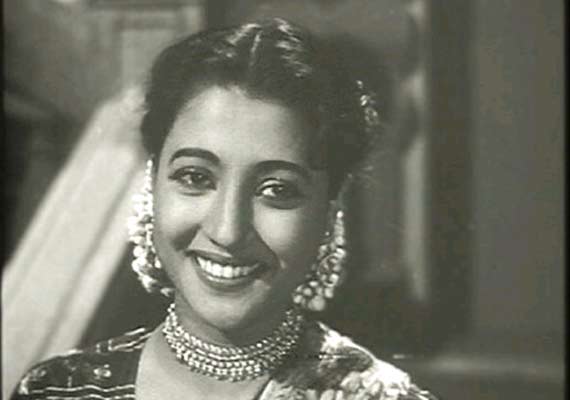My Sunday Guardian column for March 1st:
In a sketch that's part of the Tadpole Repertory's superb play Taramandal, a nervous young woman arrives at the office of a Bollywood agent. She nods when asked if she wants to be a star. But she doesn't speak Hindi — and for the most part of her time on stage, doesn't speak at all. The more he talks, the more terror-stricken she looks. Eventually he suggests, not unkindly, that she sign up as a Junior Artist, commonly known as an extra. "It'll be work. And with your looks, you'll get slotted as A-Class."
 |
| Suchitra Sen |
The aspiring star is played by a strikingly attractive actor, and to hear that fact referenced in the dialogue — "aapki looks" — seems appropriate, even necessary. It both acknowledges her beauty and dismisses it as not being enough. But is it really not enough, one wonders? And suddenly that idea — that beauty isn't all it takes to become a star — begins to seem a little bit like the wishful thinking oftheatre-wallahs. Because in fact, the film industry seems to declaim from rooftops that beauty is all. Talent, if at all it counts, is secondary.
The young Suchitra Sen — then plain Krishna Dasgupta — apparently once sat on a school bench and announced that she would be remembered long after her death. An ordinary middle class girl who was one of nine siblings, and an average student bereft of any artistic talent, all Sen had was her looks. But apparently, that was enough. "She was conscious of her great beauty... and behaved as if she... deserved every bit of the natural selection," wrote Susmita Dasgupta in a thoughtful Facebook note. At the time, a wealthy groom was the biggest prize a middle class girl could expect for her beauty. Krishna got that, too. But her stardom, says Dasgupta, came about because she believed she was meant for bigger things. Beauty was her claim upon the universe. Hindi film star Juhi Chawla recently described entering the Femina Miss India contest when in college. "I knew I was good," she said, but "there were prettier girls in my class and that always kept me grounded."
Women are constantly being rated on grounds of beauty — and rating ourselves, too. The sad thing is that it isn't just those who aspire to be models or actors, professions that overtly reward bodily perfection, who buy into this hierarchy. Seemingly, it's everyone. And that ingrained sense of superiority or inferiority, based on how you think other people think you look, can coexist with an otherwise well-formed intelligence. I was distressed to hear recently of a bright, high-achieving woman being thrilled that a college reunion still rated her among the hottest girls in her batch.
Men are rated on other things: intelligence, talent, wealth, power. Looks, not so much. That criterion, seemingly, they reserve for us. Off the top of my head, I can think of a boy in high school whose unsolicited rating of three female friends as "cute", "pretty" and "beautiful" I have never forgotten. Another male friend introduced someone a decade after college as "one of the hot girls in college". What's worse is the enshrining of this stuff as popular culture — in university fests, college mags and so on. In St. Stephen's College, premier educational institution of the land, it was long considered a "fun" thing for male students to regularly produce "chick charts" — a list of the top 10 "chicks" in college, based on their physical attributes. In 1984, soon after the pogrom against the Sikh community, they produced a "Sardine" chart — the top 10 female Sikh students rated on their looks. Filmmaker Saba Dewan, then a student there, wrote in 2012 of the uproar that followed, the all-out gender wars in which the authorities sided with the male "pranksters" against women students protesting objectification, who were termed troublemakers. St. Stephen's College in the late 1990s, when I went there, no longer had "chick charts", or at least not public ones. But very similar issues existed, and came to a head around "Miss and Mr Harmony". Ostensibly gender-neutral, it was, in practice, a contest of wit for boys, but looks for girls. The gender wars of my time ended with the entry of women into residence at St. Stephen's, for the first time in its history.
Re-watching Imtiaz Ali's Rockstar the other day, I had a moment of shock. Ali — who went to Hindu College himself — had decided that the best way to introduce his Stephanian heroine to us was to show her topping the chick chart. And the only woman we see respond to it says merely, "Dekhna kya hai? Jab tak yeh St. Stephen's mein hai, yeh hi hogi na No. 1". There it was — a thing so many women had fought so hard to get rid of, shorn of all its history, reinstated as instigator of the beauty myth.
A day after that, a friend said to me she identified with much of the rule-breaking fun that Ali's heroines had, but his actresses were too pretty. "They do what girls want, but they look like what boys want." Ah, no surprise there.
No comments:
Post a Comment